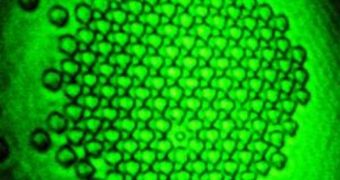A group of investigators at the Swiss Federal Institute of Technology (EPFL) in Lausanne, Switzerland announce the development of innovative mirrors made out of polystyrene beads. These structures, which are only held together by light, are created by shinning powerful lasers beams on the beads.
This study holds great potential for space exploration, analysts say, because it could set the stage for the development of ultra-light mirrors for use of future planet-hunting telescopes. For reference, the NASA Kepler Telescope that found more than 3,500 planets to date has a very small mirror.
With a diameter of 1.4 meters (4.5 feet), Kepler's mirror is unable to detect exoplanets directly. Instead, it looks for and identifies minute changes in the brightness of stars in its field of view, which may be indicative of a planet's pass between its parent star and the telescope.
When NASA launches the James Webb Space Telescope, no earlier than 2018, the spacecraft will feature the largest set of eyes ever sent to space. The satellite's optics will include 18 interlocking, hexagonal segments that will produce a mirror with a diameter of 6.5 meters (nearly 22 feet).
With the new mirror technology developed in Switzerland, it may soon become possible to construct much larger and lighter advanced optics system for spacecraft in Earth's orbit. These instruments may even be able to image the atmospheres and continents of exoplanets directly.
The EPFL team was able to create the new type of mirrors by investigating an older proposal, which stated that exploiting the force produced when laser beams hit tiny particles can be used to create larger flat, reflecting surfaces, New Scientist reports.
EPFL investigator Jean-Marc Fournier and his team carried out the new study with funds provided by the Institute for Advanced Concepts (IAC) at NASA. A single large laser was aimed at a series of polystyrene beads no wider than 150 micrometers in diameter, pinning them against a sheet of glass.
Light would normally reflect off these spheres in all directions, but the team was able to group the beads together, so they started acting just like a mirror. The team believes that this technique could be used to make space telescopes mirrors with diameters of up to 35 meters (115 feet).
“Whether this technology could be ready for a James Webb successor is quite speculative and would depend on many engineering and mission details that are not yet known,” commented the chief engineer for the JWST at Northrop Grumman Aerospace Systems, Jonathan Arenberg.
Details of the new mirrors and the technology used to create them appear in the January 13 issue of the esteemed journal Physical Review Letters.

 14 DAY TRIAL //
14 DAY TRIAL //